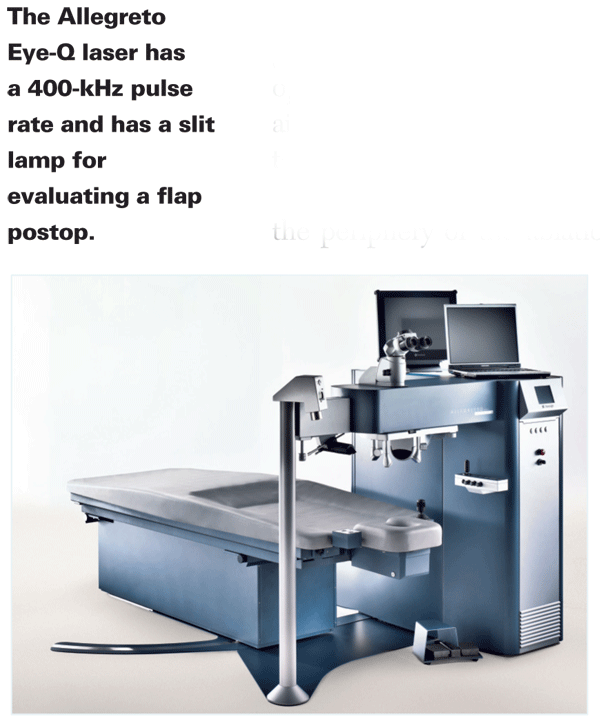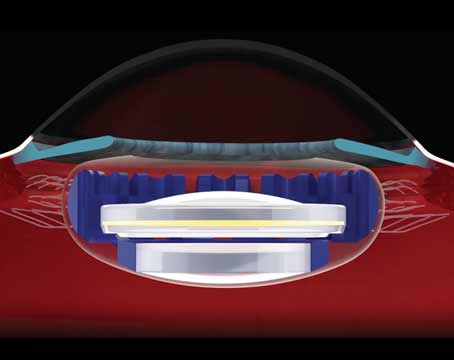When Alcon bought WaveLight and recalled its LADARVision lasers, some surgeons may have been left wondering if they should make the move to the WaveLight Allegretto Wave Eye-Q laser, which had become Alcon's flagship excimer. If you've been contemplating such a move, or are just curious about what it might be like to use the Allegretto, this article will give you some insights. Here, several Allegretto surgeons discuss the laser, its features, and how to flatten the learning curve if you decide to purchase one for your practice.
Wavefront-Optimized Surgery
In a world where every laser refractive procedure seems to be wavefront-guided, the Allegretto might seem to be going against the grain, since its primary procedure is wavefront-optimized. The wavefront-optimized procedure aims to maintain the cornea's prolate shape and to avoid inducing aberrations, especially spherical aberration, by adding some more energy to the periphery of the ablation, based on what researchers found was an optimized wavefront. It doesn't try to treat higher-order aberrations.

Don't be put off, though, say users, since wavefront-optimized procedures have been shown to provide very good results for the patients you're most likely to encounter. WaveLight, and now Alcon, approached the issue of aberrations differently with their device, finding that most patients have relatively low higher-order aberrations and do as well, if not better, with a wavefront-optimized treatment as with a wavefront-guided one.
In an analysis performed by several surgeons in 348 eyes randomized to wavefront-optimized or wavefront-guided surgery in the Allegretto's U.S. Food and Drug Administration trials, at three months 94 percent of the wavefront-optimized eyes and 95 percent of the wavefront-guided eyes saw 20/20 uncorrected. Seventy percent of the wavefront-optimized saw 20/16 vs. 63 percent of the wavefront-guided cases. The surgeons found there was no significant difference in postop root mean square values of higher-order aberrations for patients with up to 0.3 µm of RMS preop who had either procedure. It was only with values higher than 0.3 µm RMS that wavefront-guided procedures began to be helpful. Additionally, 81 percent of the patients had less than 0.3 µm RMS preop, meaning that most would do just as well with a wavefront-optimized procedure as one that was wavefront-guided, the analysis concluded.
Forging a Nomogram
Alcon has a system in place to help the new Allegretto user craft the right nomogram.
"Every surgeon's nightmare with a new laser involves what it will do to his outcomes," opines
Charles Moore, MD, of
If you're a surgeon switching from the previous 200-kHz Allegretto Wave laser to the 400-kHz Eye-Q,
Lt. Col. Chas Reilly, MD, of Lackland Air Force Base in
"With the
The Allegretto also allows surgeons latitude in tweaking the optical zone of a treatment to suit a particular patient's needs. "In the 20 percent of cases in which I perform PRK with the Allegretto, for myopes the optical zone is the same as the one I use for LASIK: 6.5 mm with a transition zone out to 9 mm," says Dr. Stein. "But for hyperopic correction with PRK, I shorten it to 6 mm with a transition to 9 mm. This is because I've found a larger transition zone is helpful with hyperopic PRK. With a smaller zone, I've found there's a greater chance of regression. We've had outstanding hyperopic results when we have to use surface ablation."
Issues of Mechanics
The Eye-Q laser puts down pulses at a very fast rate—400 kHz. Surgeons say this is, for the most part, a great benefit.
"The Eye-Q takes about two seconds per diopter," says Dr. Stonecipher. "The previous Allegretto ran at 200 kHz for treatments, and took four seconds per diopter. This is a big difference for treatments such as higher myopic corrections, hyperopic treatments and mixed astigmatism. The longer the flap is back, the more issues you have with desiccation, patient fixation and cyclotorsion."
However, at 400 kHz, things happen so fast, says Dr. Reilly, you've got to be on top of everything. "In terms of mechanics, the laser is so fast that you have to make sure everything is perfect and ready to go," he says. "If you're not paying attention, some fluid can come up on the bed suddenly and you might not catch it before it affects the ablation. Or, you might ablate the underside of the hinge, which can lead to irregular astigmatism or epithelial ingrowth if you don't catch it quickly enough."
The Eye-Q's eye tracker is very fast, and surgeons say it does a good job. However, there are rare occasions when it needs a little help. "For very small pupils, such as 1 mm or less, or very large ones of 8 mm or larger, you'll lose tracking," says Dr. Stonecipher.
"If the pupil's too large, I'll turn up the light and it will come down enough for the tracker to pick it up. On the other end, I've had maybe two patients in whom the pupil was too small. I pharmacologically dilated them with weak tropicamide 0.5%, which I felt was less likely to cause asymmetric dilation of the pupil than phenylephrine. The tropicamide brought the pupil size up to where the tracker could pick it up and I could do the treatment."
One final helpful piece of hardware is a slit lamp that's attached to the Eye-Q, obviating the need to walk the patient to another room for a slit-lamp exam postop. "The slit lamp provides outstanding visibility of the flap and the gutter," says Dr. Stein. "Because of this, I don't mark the flap with ink anymore because observing whether or not those ink marks line up is a much more gross evaluation than simply evaluating the gutter with the slit-lamp attachment. If I see that the gutter's wider in one area than another, I'll refloat the flap and get it into a better position. You still have to mark, though, if you use a microkeratome, because there's a risk for a free cap."
Overall, these surgeons think the transition to the Allegretto is a smooth one. "It's a very user-friendly laser," says Dr. Stonecipher.





